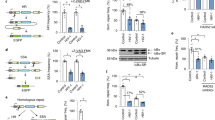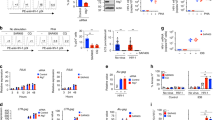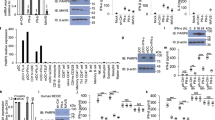Abstract
The mechanisms by which human immunodeficiency virus 1 (HIV-1) avoids immune surveillance by dendritic cells (DCs), and thereby prevents protective adaptive immune responses, remain poorly understood. Here we showed that HIV-1 actively arrested antiviral immune responses by DCs, which contributed to efficient HIV-1 replication in infected individuals. We identified the RNA helicase DDX3 as an HIV-1 sensor that bound abortive HIV-1 RNA after HIV-1 infection and induced DC maturation and type I interferon responses via the signaling adaptor MAVS. Notably, HIV-1 recognition by the C-type lectin receptor DC-SIGN activated the mitotic kinase PLK1, which suppressed signaling downstream of MAVS, thereby interfering with intrinsic host defense during HIV-1 infection. Finally, we showed that PLK1-mediated suppression of DDX3–MAVS signaling was a viral strategy that accelerated HIV-1 replication in infected individuals.
This is a preview of subscription content, access via your institution
Access options
Subscribe to this journal
Receive 12 print issues and online access
$209.00 per year
only $17.42 per issue
Buy this article
- Purchase on Springer Link
- Instant access to full article PDF
Prices may be subject to local taxes which are calculated during checkout








Similar content being viewed by others
Change history
23 January 2017
In the version of this article initially published, the fifth author's surname was spelled incorrectly (as 'Sarrami-Fooroshani'). The correct spelling is 'Sarrami-Forooshani'. Also, the cells for the third plot in Figure 1d were identified incorrectly as 'Intesrinal DCs'. The correct label is 'Intestinal DCs'. The errors have been corrected in the PDF and HTML versions of this article.
References
Steinman, R.M. Decisions about dendritic cells: past, present, and future. Annu. Rev. Immunol. 30, 1–22 (2012).
Miller, E. & Bhardwaj, N. Dendritic cell dysregulation during HIV-1 infection. Immunol. Rev. 254, 170–189 (2013).
Goujon, C. et al. Human MX2 is an interferon-induced post-entry inhibitor of HIV-1 infection. Nature 502, 559–562 (2013).
Kane, M. et al. MX2 is an interferon-induced inhibitor of HIV-1 infection. Nature 502, 563–566 (2013).
Yan, N. & Chen, Z.J. Intrinsic antiviral immunity. Nat. Immunol. 13, 214–222 (2012).
Simmons, D.P. et al. Type I IFN drives a distinctive dendritic cell maturation phenotype that allows continued class II MHC synthesis and antigen processing. J. Immunol. 188, 3116–3126 (2012).
González-Navajas, J.M., Lee, J., David, M. & Raz, E. Immunomodulatory functions of type I interferons. Nat. Rev. Immunol. 12, 125–135 (2012).
Sandler, N.G. et al. Type I interferon responses in rhesus macaques prevent SIV infection and slow disease progression. Nature 511, 601–605 (2014).
Gringhuis, S.I. et al. C-type lectin DC-SIGN modulates Toll-like receptor signaling via Raf-1-kinase-dependent acetylation of transcription factor NF-κB. Immunity 26, 605–616 (2007).
Gringhuis, S.I., den Dunnen, J., Litjens, M., van der Vlist, M. & Geijtenbeek, T.B.H. Carbohydrate-specific signaling through the DC-SIGN signalosome tailors immunity to Mycobacterium tuberculosis, HIV-1, and Helicobacter pylori. Nat. Immunol. 10, 1081–1088 (2009).
Solis, M. et al. RIG-I-mediated antiviral signaling is inhibited in HIV-1 infection by a protease-mediated sequestration of RIG-I. J. Virol. 85, 1224–1236 (2011).
Gringhuis, S.I. et al. HIV-1 exploits innate signaling by TLR8 and DC-SIGN for productive infection of dendritic cells. Nat. Immunol. 11, 419–426 (2010).
Kao, S.Y., Calman, A.F., Luciw, P.A. & Peterlin, B.M. Anti-termination of transcription within the long terminal repeat of HIV-1 by tat gene product. Nature 330, 489–493 (1987).
Yedavalli, V.S., Neuveut, C., Chi, Y.H., Kleiman, L. & Jeang, K.T. Requirement of DDX3 DEAD box RNA helicase for HIV-1 Rev–RRE export function. Cell 119, 381–392 (2004).
Naji, S. et al. Host cell interactome of HIV-1 Rev includes RNA helicases involved in multiple facets of virus production. Mol. Cell. Proteomics 11, 015313 (2012).
Soto-Rifo, R. et al. DEAD-box protein DDX3 associates with eIF4F to promote translation of selected mRNAs. EMBO J. 31, 3745–3756 (2012).
Soto-Rifo, R., Rubilar, P.S. & Ohlmann, T. The DEAD-box helicase DDX3 substitutes for the cap-binding protein eIF4E to promote compartmentalized translation initiation of the HIV-1 genomic RNA. Nucleic Acids Res. 41, 6286–6299 (2013).
Goubau, D., Deddouche, S. & Reis e Sousa, C. Cytosolic sensing of viruses. Immunity 38, 855–869 (2013).
Gao, D. et al. Cyclic GMP–AMP synthase is an innate immune sensor of HIV and other retroviruses. Science 341, 903–906 (2013).
Yan, N., Regalado-Magdos, A.D., Stiggelbout, B., Lee-Kirsch, M.A. & Lieberman, J. The cytosolic exonuclease TREX1 inhibits the innate immune response to human immunodeficiency virus type 1. Nat. Immunol. 11, 1005–1013 (2010).
Lahouassa, H. et al. SAMHD1 restricts the replication of human immunodeficiency virus type 1 by depleting the intracellular pool of deoxynucleoside triphosphates. Nat. Immunol. 13, 223–228 (2012).
Hertoghs, N. et al. SAMHD1 degradation enhances active suppression of dendritic cell maturation by HIV-1. J. Immunol. 194, 4431–4437 (2015).
Hou, F. et al. MAVS forms functional prion-like aggregates to activate and propagate antiviral innate immune response. Cell 146, 448–461 (2011).
Clark, K., Plater, L., Peggie, M. & Cohen, P. Use of the pharmacological inhibitor BX795 to study the regulation and physiological roles of TBK1 and IκB kinase epsilon: a distinct upstream kinase mediates Ser172 phosphorylation and activation. J. Biol. Chem. 284, 14136–14146 (2009).
Saha, S.K. et al. Regulation of antiviral responses by a direct and specific interaction between TRAF3 and Cardif. EMBO J. 25, 3257–3263 (2006).
Vitour, D. et al. Polo-like kinase 1 (PLK1) regulates interferon (IFN) induction by MAVS. J. Biol. Chem. 284, 21797–21809 (2009).
Elia, A.E. et al. The molecular basis for phosphodependent substrate targeting and regulation of Plks by the Polo-box domain. Cell 115, 83–95 (2003).
Ji, J.H. et al. Purification and proteomic identification of putative upstream regulators of polo-like kinase 1 from mitotic cell extracts. FEBS Lett. 584, 4299–4305 (2010).
Rabizadeh, S. et al. The scaffold protein CNK1 interacts with the tumor suppressor RASSF1A and augments RASSF1A-induced cell death. J. Biol. Chem. 279, 29247–29254 (2004).
Praskova, M., Khoklatchev, A., Ortiz-Vega, S. & Avruch, J. Regulation of the MST1 kinase by autophosphorylation, by the growth inhibitory proteins RASSF1 and NORE1, and by Ras. Biochem. J. 381, 453–462 (2004).
de Roda Husman, A.M. et al. Association between CCR5 genotype and the clinical course of HIV-1 infection. Ann. Intern. Med. 127, 882–890 (1997).
Pothlichet, J. et al. A loss-of-function variant of the antiviral molecule MAVS is associated with a subset of systemic lupus patients. EMBO Mol. Med. 3, 142–152 (2011).
Pertel, T., Reinhard, C. & Luban, J. Vpx rescues HIV-1 transduction of dendritic cells from the antiviral state established by type 1 interferon. Retrovirology 8, 49 (2011).
Manel, N. et al. A cryptic sensor for HIV-1 activates antiviral innate immunity in dendritic cells. Nature 467, 214–217 (2010).
Adams, M. et al. Cellular latency in human-immunodeficiency-virus-infected individuals with high CD4 levels can be detected by the presence of promoter-proximal transcripts. Proc. Natl. Acad. Sci. USA 91, 3862–3866 (1994).
Luban, J. Innate immune sensing of HIV-1 by dendritic cells. Cell Host Microbe 12, 408–418 (2012).
Archambault, V. & Glover, D.M. Polo-like kinases: conservation and divergence in their functions and regulation. Nat. Rev. Mol. Cell Biol. 10, 265–275 (2009).
Li, S., Zhang, Y. & Xu, W. Developments of polo-like kinase 1 (Plk1) inhibitors as anticancer agents. Mini Rev. Med. Chem. 13, 2014–2025 (2013).
Hunt, P.W. et al. Gut epithelial barrier dysfunction and innate immune activation predict mortality in treated HIV infection. J. Infect. Dis. 210, 1228–1238 (2014).
Roberts, L. et al. Genital tract inflammation during early HIV-1 infection predicts higher plasma viral load set point in women. J. Infect. Dis. 205, 194–203 (2012).
Fernandez, S. et al. CD4+ T cell deficiency in HIV patients responding to antiretroviral therapy is associated with increased expression of interferon-stimulated genes in CD4+ T cells. J. Infect. Dis. 204, 1927–1935 (2011).
Fraietta, J.A. et al. Type I interferon upregulates Bak and contributes to T cell loss during human immunodeficiency virus (HIV) infection. PLoS Pathog. 9, e1003658 (2013).
Wheeler, L.A. et al. TREX1 knockdown induces an interferon response to HIV that delays viral infection in humanized mice. Cell Rep. 15, 1715–1727 (2016).
Mesman, A.W. et al. Measles virus suppresses RIG-I-like receptor activation in dendritic cells via DC-SIGN-mediated inhibition of PP1 phosphatases. Cell Host Microbe 16, 31–42 (2014).
Booiman, T., Setiawan, L.C. & Kootstra, N.A. Genetic variation in Trex1 affects HIV-1 disease progression. AIDS 28, 2517–2521 (2014).
Sarrami-Forooshani, R. et al. Human immature Langerhans cells restrict CXCR4-using HIV-1 transmission. Retrovirology 11, 52 (2014).
Quakkelaar, E.D. et al. Susceptibility of recently transmitted subtype B human immunodeficiency virus type 1 variants to broadly neutralizing antibodies. J. Virol. 81, 8533–8542 (2007).
Kinoshita, T. et al. Detection of mRNA for the tax1 (rex1) gene of human T cell leukemia virus type I in fresh peripheral blood mononuclear cells of adult T cell leukemia patients and viral carriers by using the polymerase chain reaction. Proc. Natl. Acad. Sci. USA 86, 5620–5624 (1989).
Acknowledgements
We thank L. Westera, C. Buskens and W. Bemelman (AMC, Amsterdam, the Netherlands) for the intestinal tissue cell suspensions and C.L. Verweij (VUmc, Amsterdam, the Netherlands) for the IFNB, ISG15 and Mx2 primer sequences. HIV-2 virus, MT-2 cells, AZT and gp120 were obtained through the NIH AIDS Research and Reference Reagent Program. Supported by Aids Fonds (2012042; S.I.G.), the Netherlands Organization for Scientific Research (NWO) VICI 918.10.619; T.B.H.G.) and the European Research Council (Advanced grant 670424; T.B.H.G.).
Author information
Authors and Affiliations
Contributions
S.I.G. designed and supervised research, and performed experiments; N.H., T.M.K., E.M.Z.-W., R.S.-F., J.K.S., N.H.v.T., C.M.S.R. and A.D. performed experiments; N.H. generated the 293T CRISPR knockout cell lines; N.A.K. and T.B. provided data from the Amsterdam cohort studies (ACS) on HIV-1 infection and AIDS; K.A.v.D. assisted with virus isolation; and S.I.G. and T.B.H.G. interpreted results and wrote the paper.
Corresponding authors
Ethics declarations
Competing interests
The authors declare no competing financial interests.
Integrated supplementary information
Supplementary Figure 1 Raf-1 inhibition does not affect TLR4-induced type I interferon responses.
Real-time PCR (RT-PCR) analyses of IFNB, ISG15, TRIM5, TRIM22 and APOBEC3G mRNA in moDCs 6 h after stimulation with TLR4 ligand LPS, in the absence or presence of Raf-1 inhibitor GW5074. Mean ± SD; n = 3.
Supplementary Figure 2 DDX3 sensing pathway is independent from RIG-I–MDA5 and cGAS pathways in DCs.
(a-d) RT-PCR analyses of IFNB mRNA in moDCs 4 h after infection with HIV-1BaL (a,b) or stimulation with RIG-I–MDA5 ligand poly(I:C)-LyoVec, TLR4 ligand LPS (d), cGAS ligand HSV DNA coupled to LyoVec or STING ligand 3’3’-cGAMP (d), in the absence or presence of Raf-1 inhibitor GW5074 (a,b), reverse transcription inhibitor AZT or integrase inhibitor raltegravir (RAL) (b) and after silencing (siRNA) of indicated proteins (a-d). Mean ± SD; n = 4 (a,c,d), 3 (b). ** p < 0.01, * p < 0.05 (Student’s t-test). The data shown in (b) are an addendum to the data presented in Fig. 2b.
Supplementary Figure 3 Depletion of protein expression in human 293T cells by CRISPR–Cas9-directed genome editing.
Immunoblot (IB) analyses of depletion (Δ) of indicated proteins by transfection of 293T cells with control or specific guide RNA and Cas9-expressing plasmids.
Supplementary Figure 4 Raf-1 and MST1 but not PLK1 inhibit HIV-1 transcription, whereas Raf-1 blocks HIV-2 but not HTLV-1 transcription.
(a,b) RT-PCR analyses of tat-rev (HIV-1, HIV-2) or tax-rex (HTLV-1) mRNA in moDCs 6 h after infection with HIV-1BaL (a), HIV-2 or HTLV-1 (b), in the absence or presence of Raf-1 inhibitor GW5074 (a,b), and after silencing (siRNA) of Raf-1, PLK1 or MST1 (b). Mean ± SD; n = 6 (a), 2 (b).
Supplementary Figure 5 IRF3 activation is suppressed by a MST1–PLK1 cascade after HIV-1 infection.
Immunoblot (IB) analyses of Ser396 phosphorylation of IRF3 in nuclear extracts (NE) of moDCs 3 h after HIV-1BaL infection, after silencing (siRNA) of MST1 or PLK1. RNA polymerase II (RNAP2) served as loading control. Representative of 2 independent experiments.
Supplementary Figure 6
(a-c) Flow cytometry analyses of DDX3 (a) or MAVS (b,c) expression in control-, DDX3- or MAVS-silenced (siRNA) moDCs 48 h after transfection of plasmids with RNAi-resistant cDNAs encoding wild-type DDX3 (a) or wild-type MAVS (b,c). In (c), minor genotype moDCs were transfected. FI, fluorescence intensity; FSC, forward scatter. Representative of 4 (a,b) or 3 (c) independent experiments. (d) RT-PCR analyses of IFNB mRNA in control- or MAVS-silenced minor genotype moDCs 4 h after infection with HIV-1BaL, in the absence or presence of Raf-1 inhibitor GW5074, after complementation of MAVS expression via transfection of plasmids with RNAi-resistant cDNA encoding wild-type (QS, Q198,S409) MAVS. Mean ± SD; n = 4. ** p < 0.01, * p < 0.05 (Student’s t-test).
Supplementary Figure 7 DC-SIGN signaling via Raf-1–MST1–PLK1 suppresses signaling downstream of MAVS after sensing of abortive HIV-1 transcripts by the RNA helicase DDX3.
DC-SIGN signaling via Raf-1-MST1-PLK1 suppresses signaling downstream of MAVS after sensing of abortive HIV-1 transcripts by RNA helicase DDX3.
Supplementary Figure 8 Silencing of protein expression in human DCs by RNA interference.
(a-q) Realtime PCR (left panels), flow cytometry (middle panels) and immunoblot (right panels) analsyes of indicated mRNA and proteins in moDCs silenced for indicated proteins using specific siRNAs and non-targeting siRNA as a control (left panels; mean ± SD, n ≥ 7; middle panels; FI, fluorescence intensity; representative of at least 3 independent experiments; right panels; representative of 2 independent experiments).
Supplementary information
Supplementary Text and Figures
Supplementary Figures 1–8 and Supplementary Tables 1 and 2 (PDF 10138 kb)
Rights and permissions
About this article
Cite this article
Gringhuis, S., Hertoghs, N., Kaptein, T. et al. HIV-1 blocks the signaling adaptor MAVS to evade antiviral host defense after sensing of abortive HIV-1 RNA by the host helicase DDX3. Nat Immunol 18, 225–235 (2017). https://doi.org/10.1038/ni.3647
Received:
Accepted:
Published:
Issue Date:
DOI: https://doi.org/10.1038/ni.3647
This article is cited by
-
Functions of MAP3Ks in antiviral immunity
Immunologic Research (2023)
-
HIV-1 Vif suppresses antiviral immunity by targeting STING
Cellular & Molecular Immunology (2022)
-
Regulation of RIG-I-like receptor-mediated signaling: interaction between host and viral factors
Cellular & Molecular Immunology (2021)
-
Inhibition of the Dead Box RNA Helicase 3 Prevents HIV-1 Tat and Cocaine-Induced Neurotoxicity by Targeting Microglia Activation
Journal of Neuroimmune Pharmacology (2020)
-
Human dendritic cell-specific ICAM-3-grabbing non-integrin downstream signaling alleviates renal fibrosis via Raf-1 activation in systemic candidiasis
Cellular & Molecular Immunology (2019)



